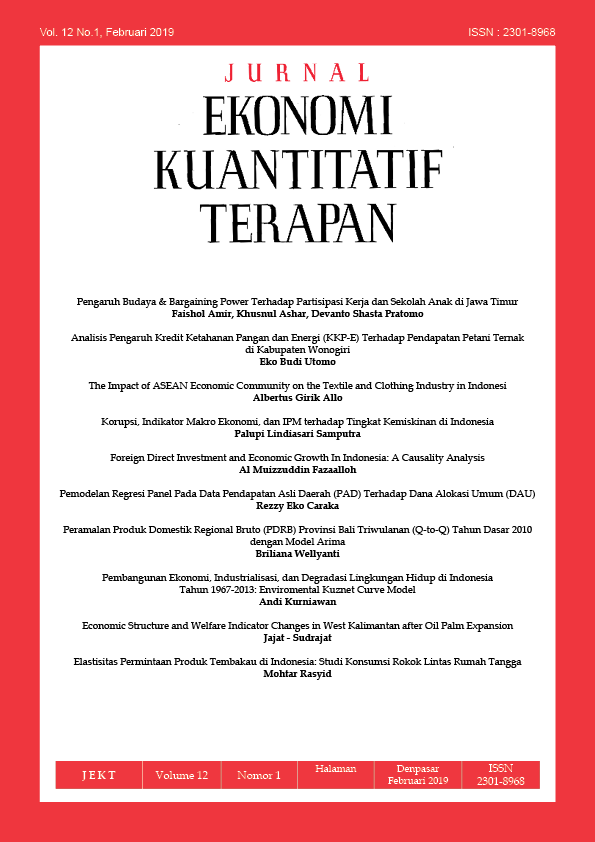Pengaruh Budaya & Bargaining Power Terhadap Partisipasi Kerja dan Sekolah Anak di Jawa Timur
Abstract
This paper examines the influence of cultural and bargaining Power on child labor and school participation in East Java. The prevalence of children aged 10-17 years who work in East Java is around 4.74%. About 28.03% of children who work are still in school. Whereas school dropouts reach 11.28%. Referring to the theory of collective model and using the method of multinomial logit regression analysis on the Intercensal Population Survey (SUPAS) data in 2015, this paper concludes that culture proxied through tlatah had a significant effect. Children who come from Arek tlatah are most likely to work. Children from the Pandalungan tlatah are the least likely to go to school. While children from Madura Pulau tlatah are most likely to go to school while working.. Interestingly, if maternal education is equal or even higher than that of fathers, children's participation in work increases and conversely the participation of school children actually decreases.
Downloads
References
Akabayashi, H & G. Psacharopoulos. 1999. The Trade-Off Between Child Labour And Human Capital Formation: A Tanzanian Case Study. Journal of Development Studies 35: 120-140
Ayu, Cintia Putri & Bachtiar, Nasri. 2017. Analisis Faktor-Faktor Mempengaruhi Pekerja Anak Di Sumatera Barat. Fakultas Ekonomi Universitas Andalas
Badan Pusat Statistik. 2009. Pekerja Anak di Indonesia 2009. Jakarta
Badan Pusat Statistik. 2015. Petunjuk Teknis Pencacahan SUPAS 2015. Jakarta
Badan Pusat Statistik. 2017. Analisis Kemiskinan Anak dan Deprivasi Hak-hak Dasar Anak di Indonesia. Jakarta
Barham, V et al. 1995. Education and the poverty trap. European Economic Review 39: 1257-1275.
Basu, K & Ranjan Ray. 2002. The Collective Model of the Household and an Unexpected Implication for Child Labor. The World Bank Office of the Senior Vice President H Development Economics: Policy Research Working Paper 2813
Contreas, Dante et al. 2007. Child Labor and Schooling in Bolivia: Who’s Falling Behind? The Roles of Domestic Work, Gender and Ethnicity. Departemento De Economia, Universidad De Chile
Donni, O. 2003. Collective household labor supply: Non-participation and income taxation. The Journal of Public Economics, 87(5/6), 1179-98.
Edmonds, E. V., & Pavcnik, N. 2005. Child Labor in the Global Economy. Journal of Economic Perspectives, 19(1).
Edmonds, E. V. 2007. Child labor. NBER Working Paper No. 12926. National Bureau Of Economic Research
Guarcello, L et al. 2004. Child labour and access to basic services Evidence from five countries. UCW - Understanding Children’s Work Project
Gujarati, Damodar N. 2010. Dasar-Dasar Ekonometrika Buku 1. Edisi 5. ed. Dedy A. Halim. Jakarta: Penerbit Salemba Empat.
Hopkins et al. 1994. Women’s Income and Household Expenditure Patterns: Gender or Flow? Evidence from Niger. American Journal of Agricultural Economics, Vol. 76 (7), pp. 1219-1225.
Himmelwei et al. 2013. Sharing of Resources within the Family and the Economics of Household Decision-making. The Open University. United Kingdom.
Kurosaki et al. 2006. Child Labor and School Enrollment in Rural India: Whose Education Matters?. Forthcoming in The Development Economics, Vol 44 (6).
McEwan, Patrick J.& Marisol Trowbridge. 2007 The Achievement of Indigenous Students in Guatemalan Primary Schools. International Journal of Educational Development 27 (1): 61–76.
Mehrotra, Santosh & Mario Biggeri. 2010. Children in home worker households in Pakistan and Indonesia. International Journal of Manpower, Vol. 31 Issue: 2, pp.208-231
Pratomo, Devanto S. 2017. Does Poverty Affects Child Labour and School Attendance?: Evidence from Indonesia. Proceeding The 3 International Indonesian Forum for Asian Studies Challenges of globalisation.
Ray, Ranjan. 2000. Child Labors, Child Schooling, and Their Interaction with Adult Labor: Empirical Evidence for Peru and Pakistan. The World Bank Economic Review, 14(3):347-67.
Setyari, Ni Putu Wiwin. 2013. Distribusi Alokasi Sumber Daya Dalam Rumah Tangga di Indonesia : Anak Sekolah atau Bekerja?. Jurnal Piramida Vol. IX No. 2 : 59 - 71
Sutarto, Ayu. 2004. Pendekatan Kebudayaan dalam Pembangunan Provinsi Jawa Timur. 1 ed. Jember: Kompyawisda
Tang, Can et al. 2016. Child labor in China. Journal of China Economic Review. Elsevier B.V.
Thomas, Duncan et al. 1999. Distribution of Power Within the Household and Child Health. Unpublised manuscript, download at www.rand.org
Vasquez, William F & Alok K. Bohara. 2010. Household Shocks, Child Labor, And Child Schooling. Latin American Research Review, Vol. 45, No. 2. © 2010 by the Latin American Studies Association
Vermeulen, F. 2006. A collective model for female labor supply with nonparticipation and taxation. Journal of Population Economics, 19(1), 99-118




















